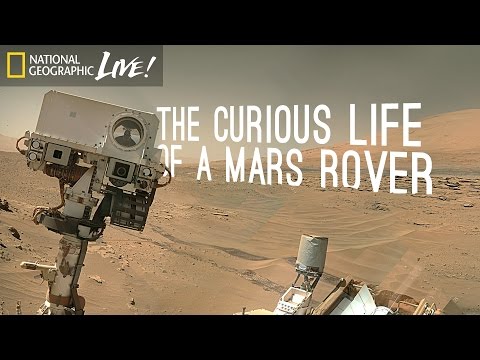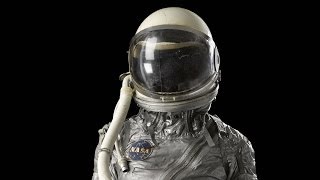NASA | Exploration Mission-1 – Pushing Farther Into Deep Space
In the next eight minutes you’llexperience a twenty-five-and-a-half daymission from roll out to recovery. Thefirst integrated flight test of theOrion spacecraft and the Space LaunchSystem rocket, launching from theKennedy Space Center, is about to unfold. This is the first of many missions tocome that will use the deep-spaceexploration system to prepare our team,our ship, and our astronauts for humanoperations in deep space. Rollout from the Vehicle Assembly Building signals that launch is near. Sitting atop the mobile launcher the crawler transporter moves along the crawler way towards thehistoric launch pad 39b at the KennedySpace Center at a top speed of 1 mile an hour. After traveling over 4 miles,the rocket and spacecraft climb up aramp and are positioned over a flametrench. Once in position, the mobilelauncher is lowered onto support postsand the crawlers roll away to a safe distance. Final checks are performed atthe pad, including crew cabin closeout viathe access arm sitting over 300 feetabove the surface of the launch pad. The launch date is set and the teams areprepared for the mission that is about to occur. At sunrise on launch dayengineers in the launch control centerhave already powered up the spacecraftin the rocket and loaded the core stageand upper stage with cryogenic fuel. Aslaunch window open approaches finalchecks are performed and when allsystems are go terminal countdown is initiated. The big physics of launch areabout to be put on full demonstration. Umbilical plates weighing hundreds ofpounds await their cue to retract toclear the path of the rocket at liftoff,some mounted on arms the size oftractor-trailers. The mighty core stageengines are prepared for engine startas they are thermally conditioned for anonrush of cryogenic fuel in the heat of ignition. At T-minus 15 seconds soundsuppression is activated, cascading waterinto the flame trench to dampen theacoustic shock, and as the core stageengines achieve full throttle shockdiamonds appear. At booster ignition theflame trench is flooded with fire. At first motion all umbilical arms areretracted and the rocket clears thetower in just seconds. At liftoff thevehicle produces 8. 8million pounds of thrust and lofts thevehicle weighing nearly 6 million pounds and standing 32 stories tall to orbit. Propelled by a pair of five-segment boosters andfour liquid engines, therocket achieves maximum dynamic pressureonly 90 seconds into the mission–theperiod of greatest atmospheric force onthe structure of the rocket. Thousandswill gather in Florida to watch our shipget smaller and smaller and leave theSpace Coast behind. Approximately two minutes into the missionthe boosters will have consumed all oftheir solid propellant and are safelyjettisoned. The rocket will continue onguiding itself to orbit with magnificentprecision. Just three minutes into themission the service module fairings arejettisoned to lighten the vehicle andexpose Orion solar arrays. Just 40seconds later the launch abort system isalso jettisoned. It is no longer needed:Orion could safely abort at any time. Once at the desired velocity target the core stage engines are shut down and the core stage separates. The interim cryo propulsion stage with Orion will continue to orbit the Earth. Along the way they will past through the altitudeof the International Space Station at250 statute miles. During this firstorbit the solar arrays are deployed sothat Orion no longer needs battery power. It can now produce its own power. Following solar array deployment, the arrays are positioned into a load-bearing configuration to preparefor the perigee raise maneuver. The raisemaneuver will ensure an Earth orbit anduse the thrust provided by the interimcryo propulsion stage. Once the perigeeraise maneuver is completeOrion systems are checked prior tocommitting to the translunar injectionor TLI maneuver. The TLI maneuver must besuccessfully completed to depart Earthorbit. The TLI burn is approximately 20minutes in duration and increases thespacecraft’s velocity over 9,000 feetper second–a speed change faster than ahigh-powered rifle bullet travels. Following TLI, Orion is committed to alunar trajectory just one-and-a-halfhours after launch. Once complete, thespacecraft adapter will remain with theinterim cyro propulsion stage and theywill separate from Orion. As Orion departs low-Earth orbit it will flythrough the orbital debris fieldencircling the Earth. Past the globalpositioning navigation satellites,past the communication satellites ingeostationary orbit, and through the VanAllen radiation belts on into the deepspace radiation environment. Orion is nowentering in outbound coast phase. Thespacecraft is uniquely designed tonavigate, communicate, and operate in thisdeep space environment. The outboundcoast of the Moon will takeapproximately 4 days. As Orion approachesthe Moon, the service module will be usedto perform a critical lunar gravityassist maneuver, allowing the ship toenter a distant retrograde orbit about the Moon. The Moon will get larger andlarger in the window and at closestapproach Orion will be just 62miles from the surface of the Moon. As the spacecraft flies around the far sideof the Moon we will lose allcommunication back on Earth and for aperiod of time Orion will be on its own. Mission Control will await acquisitionof signal and as we lock on a newgeneration will see their first Earthrise. The spacecraft is now in thedistant retrograde orbit, where itssystems will be tested in the deep spaceenvironment for over a week. Along theway our ship will travel farther fromEarth than any human-capable spacecrafthas ever gone. At the farthest pointOrion will be some 1,000 times fartherfrom Earth than the International SpaceStation, at over 270,000 miles away. Teams in Mission Control Houston and at NavalBase San Diego will prepare for Orion’sreturn home and the recovery ship willset sail for the recovery zone in the Pacific Ocean. Orion will exit the distant retrogradeorbit with another lunar gravity assistand service module engine firing. Alongthe way the trajectory will be adjustedto target the Earth’s thin atmosphere atover a quarter-million miles away andensure precision landing in the PacificOcean following a direct entry. During the coast home Orion will maintain the desired tail to Sun attitude tooptimize spacecraft cooling and maximizepower production in the deep spaceenvironment. Another 4 days’ returncoast home to Earth. As our home planet fills the windows of Orion an important contribution from ourEuropean partners, called the servicemodule, has done its job. The service module is jettisoned and separates. Following separation the world’s largest heat shield will be oriented into the direction of travelto prepare for entry interface and analtitude of 400,000 feet. At entry interface, Orion will hit theEarth’s atmosphere traveling at a speedof 24,500 miles an hour and decelerate up to nine timesthe force of gravity. The heatshield will protect the spacecraft fromtemperatures half as hot as the surfaceof the Sun–approaching 5,000degrees Fahrenheit. Orion will continue to decelerate, pass through the soundbarrier, and announce its arrival to the waiting recovery team with a sonic boom. Following peak heating a protectivethermal cover that sits over theparachutes will be jettisoned. Thisbegins a series of parachute deployments. The drogue chute deployment series isdesigned to stabilize and slow thespacecraft in a period of less than 20minutes–Orion will slow from the speed of Mach32 to 0 at splashdown. The three mainparachutes will deploy and slowly unfurland suspend the 22,000 pound capsule andallow it to gently descend to thesurface of the ocean. After 25-and-a-halfdays, and a total distance traveledexceeding 1. 3 million miles, a precisionlanding within eyesight of the recovery ship. Following splashdown Orion willremain powered for a period of time asNavy divers approach in small boatsfrom the waiting recovery ship. After abrief inspection for hazards, the diverswill hook up tending lines and a towline. The capsule will be then towedinto the well deck of the recovery ship,and once the capsule clears the sterngate, the gate will be closed, the welldeck will be drained, and we will bringour ship home. We invite you to followalong at www. NASA. gov/exploration













